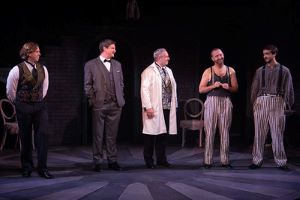Stepping into the beautiful sanctuary of St. James Episcopal Church for this concert was, for me, a reminder that when words and reason fail, music alone can console and heal; especially in the wake of tragic shootings that made recent national headlines. This beautifully programmed concert by the Carolina Concert Choir was conducted by Bradford Gee, the ensemble’s musical director, with accompanists Katherine Price and Karen Areheart (the latter also playing handbells), and guest harpist Judy Wolter-Bailey. Their program consisted of works by Renaissance composers, traditional English and Spanish carols in contemporary arrangements, with Benjamin Britten’s Ceremony of Carols, Op. 28 as the afternoon’s musical centerpiece.
The program opened with “O Come, O Come Emmanuel,” calm and centering in Alice Parker’s rather simple arrangement. “Lo! How a Rose E’er Blooming,” a chorale movement from Hugo Distler’s 1933 oratorio Die Weihnachtsgeschichte (The Christmas Story), was full-textured and beautifully voiced. These two works set the stage for Britten’s Ceremony of Carols in Julius Harrison’s 4-part SATB version, composed in 1955, thirteen years after Britten’s original.
Britten’s popular work was born in uneasy circumstances, when the composer was on board a Swedish cargo ship returning at great risk to England from America during World War II. The music in its settings of ancient carols is joyous and uplifting throughout. Framed by its opening and closing “Hodie Christus natus est” chant, the series of movements unfold as sonic jewels, some of them with soloists (Judy Meinzer in “That yongë Child,” Kathryn Wells in the spirited “Balulalow,” Kathryn Wells and Wayne Arrowood in “In Freezing Winter Night,” and Lisa Hamilton and Karen Areheart in “Spring Carol”). The harp conjures up an ancient musical world with some of its ties to folk traditions, and also displays some of Britten’s most original writing for the instrument. Judy Wolter-Bailey performed a stunning harp accompaniment throughout, and was featured solo in the Interlude, a movement which began with long and sustained tones which literally blossomed into brilliant and sweeping passages played all over the instrument.
The music after intermission was delightfully varied, and consisted first of several a cappella Renaissance works, performed with good intonation and exquisite ensemble: “A Sound of Angels” by Christopher Tye, “Ave Maria” by Jacob Arcadelt,” and “O Magnum Mysterium” by Tomas Luis de Victoria. Three spirited Spanish pieces formed the next set: “Riu, riu, chiu” ascribed to Mateo Flecha the elder and performed with hand-held percussion, “A La Nanita Nana” arranged by Christopher Azzara, and “Esta Noche” arranged by John Rutter in bold Spanish rhythms. Morten Lauridsen’s “O Nata Lux,” the third motet of a set of five comprising his Lux Aeterna, was stunning in its declamatory simplicity and soaring melodic lines.
The final carols, all arranged by Mack Wilberg, originated from various parts of the world. The Catalonian “Fum Fum, Fum” featured a piccolo-like part in the piano’s treble register and ended comically with voices and piano vying for the last “utterance” of the word “Fum.” “Still, Still, Still” from Austria had a heavily-written accompaniment which seemed a little out of character with the “stillness” so often mentioned in its text. “Ding! Dong! Merrily on High” featured an even busier piano accompaniment, brilliantly played by Ms. Price to simulate the bells of its choral text. Two encores followed; an a cappella arrangement of “Deck the Halls” which showcased the clarity and agility of each choral section, and the choir’s traditional concert closer by Kenton Coe, “A Quiet Alleluia,” which served as a lovely benediction to this wonderful program.












